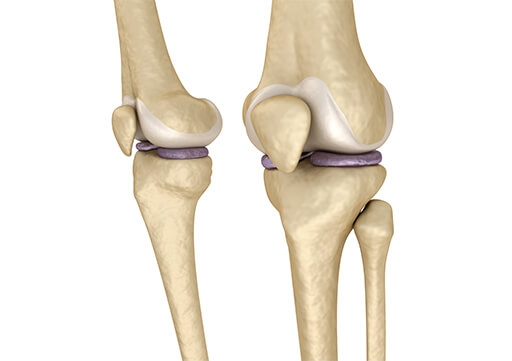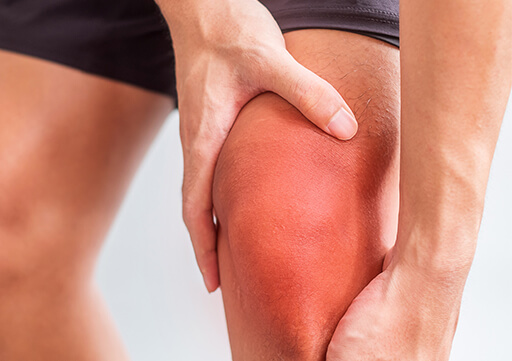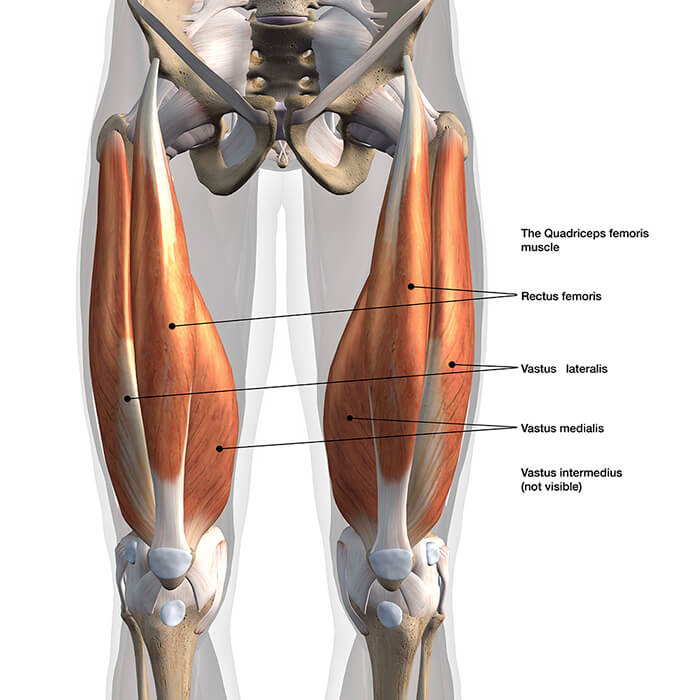What is Patellofemoral Pain Syndrome?

Patellofemoral Pain Syndrome is an umbrella term that refers to pain in the front (anterior) part of the knee around the patella (kneecap). The term ‘Patellofemoral knee pain’ has been used for approximately the last 30-40 years replacing the term “chondromalacia patella’ which was used for half a century before that.
Patellofemoral Pain Syndrome mainly affects younger age group with women showing the symptoms more often than men.
It is often a diagnosis used when other causes of anterior knee pain have been excluded.
What are the other causes of anterior knee pain?
There are several including Knee Bursitis, Osgood Schlatter’s Disease, Tendinitis and Arthritis.
Patellofemoral Pain Syndrome is a chronic condition that tends to worsen with activities such as squatting, climbing stairs and running
The knee has two major joints, the tibiofemoral joint and the patella femoral joint. In Patellofemoral Pain syndrome the problem is localised in the patellofemoral joint
The Patellofemoral Joint
The Patellofemoral joints consists of the Femur articulating with the tibia and patella. These structures are connected to each other via ligaments, tendon, muscles and retinaculum.
The patella (kneecap) is classed as a sesamoid bone and slides up and down the knee during bending and straightening the knee. The Patella itself has tendons attached above and below it, the quadricep tendon and patella tendon respectively.

Two conditions we often see Patellofemoral knee syndrome confused with is chondromalacia patellae and patella tendinitis.
Degeneration of the patella tendon is known as jumpers knee (patella tendinitis).
Swelling and irritation of the site of attachment of the patella tendon on the tibia is known as Osgood-Schlatters Disease.
The Patella attaches to the strong quadricep muscles via the quadricep tendon and a band of thickened deep fascia known as the retinaculum
On the underside of the patella is thick cartilage. This can be up to 5mm thick which is the densest are of such cartilage in the body. It is both a good lubricator with strong shock absorbing qualities
The Patella is there to provide protection to the front part of the knee and to offer increased movement of the knee via the increased mobility of the tendons it is attached to.
The Patella sits in the groove of the femur called the trochlear groove. Upon movement it is stabilised or held in position by several muscles from both the Quadriceps and Hamstrings. These muscles often work together pulling the patella in different directions when a person bends or straightens the knee.
When a person bends the knee, the compressive force on the patella can reach up to eight times bodyweight. In patients with patellofemoral pain syndrome, this movement often causes the greatest pain.
What are the symptoms of Patellofemoral Pain Syndrome?
The main symptoms are pain and crepitations (feeling of cracking) within the patellofemoral joint, especially when the knee is flexed or during palpation of the patella.
Pain is the most common symptom in most patients during and after physical activity or after walking up/downstairs and squatting.
Pain can also be experienced when the person is sat stationary or when driving especially in slow moving traffic where repeated knee bending and straightening is required for the clutch/gas pedal in stop start manoeuvres.
In addition, the knee ‘giving way’ is also reported along with knee stiffness and swelling.
Although the symptoms of patella femoral pain can be mild, when moderate to severe they can affect your day to day life or stop you participating in physical activity.
Causes of Patellofemoral Pain Syndrome
Much controversy still exists regarding the cause of patellofemoral knee pain. The causes are often a combination of several factors (multifactorial) and each individual case can vary.

Research is still being conducted to try and find which cause is the strongest but as yet no one clear cause has been identified by any of the studies
It is therefore important to ensure a thorough examination of the hip and knee muscles and tendons as well as an evaluation of the foot biomechanics.
Why is the foot examination required when the pain is in the knee?
Sometimes the pain may be localised in the knee, but the source of the problem is the foot. Excessive pronation or supination can cause patellofemoral pain
Foot pronation can cause rotation of the tibia/femur causing a deviation of the patella from its natural alignment. This can contribute to “patella mal-tracking’ which alters the way the patella glides up and down in the trochlear groove.
It is also important to assess foot biomechanics as being flatfooted or over pronation may alter knee alignment.
We will discuss the major causes of Patellofemoral Knee pain
Patellar orientation and alignment
The way the patella is orientated can affect the way it glides up and down the femoral groove. If it is tilted or ‘tracks’ more to one side, it may glide more towards one side of the femur which can cause increased compression and pain.
What can cause this difference in orientation of the patella?
It may be an anatomical variation or there can even be a difference in the orientation from one knee to the other knee in the same patient
A small deviation of the patella can effect the balance of the muscles and tendons around the knee and cause knee pain.
Conversely, muscular imbalances in the knee/hip muscles can cause Patellofemoral pain syndrome

A simple example is if the Vastus Medialis Oblique (VMO) muscle (the ‘tear drop’ Quadricep muscle on the inside of the thigh) is weak, the Vastus Lateralis muscle (quadricep muscle on the outside of the thigh) can exert a pull on the patella to the outer aspect of the knee.
This can cause overuse of the underside of the patella on the outer aspect and after repeated movements and over time can cause pain and possible wearing away of the cartilage on the underside of the patella
Another example is when the hip muscles (especially gluteus medius) are weak. These muscles are a strong hip external rotator (allows the thigh to remain upright during walking or running but when weak this may cause the knee to ‘buckle’ inwards)
This would cause the Patella to go off track (patella mal-tracking) and again cause it to tilt to the outside causing knee pain.
Other causes can include knee hypermobility where due to increased knee hyperextension, the patella is more ‘compressed’ against the patella especially on standing causing pain and discomfort.
An increased Q angle, Genus Varus or Valgus, tightness in the ITB band and tight calf or hamstring muscles are also associated with Patellofemoral pain.
Which activities make Patellofemoral pain worse?
- Walking downhill
- Wearing high heels
- Walking downstairs
- Pain when sitting with flexed knees for a long period of time
How can I treat Patellofemoral Pain?
A key component of treating Patellofemoral knee pain is rehabilitation exercises. Here at MyMSK clinic we advised on Quadricep strengthening, identifying and treating any hip or foot biomechanical issues.
Exercises such as single leg squats without knee passing the toes, strengthening the VMO muscles, hip abductor strengthening are usually incorporated into the rehabilitation protocol.
Foot orthoses in those identified with foot biomechanical issues can also be hugely helpful.
Often knee injections including Visco-supplementation and Prolotherapy can help greatly when looking at treating the condition long term.




